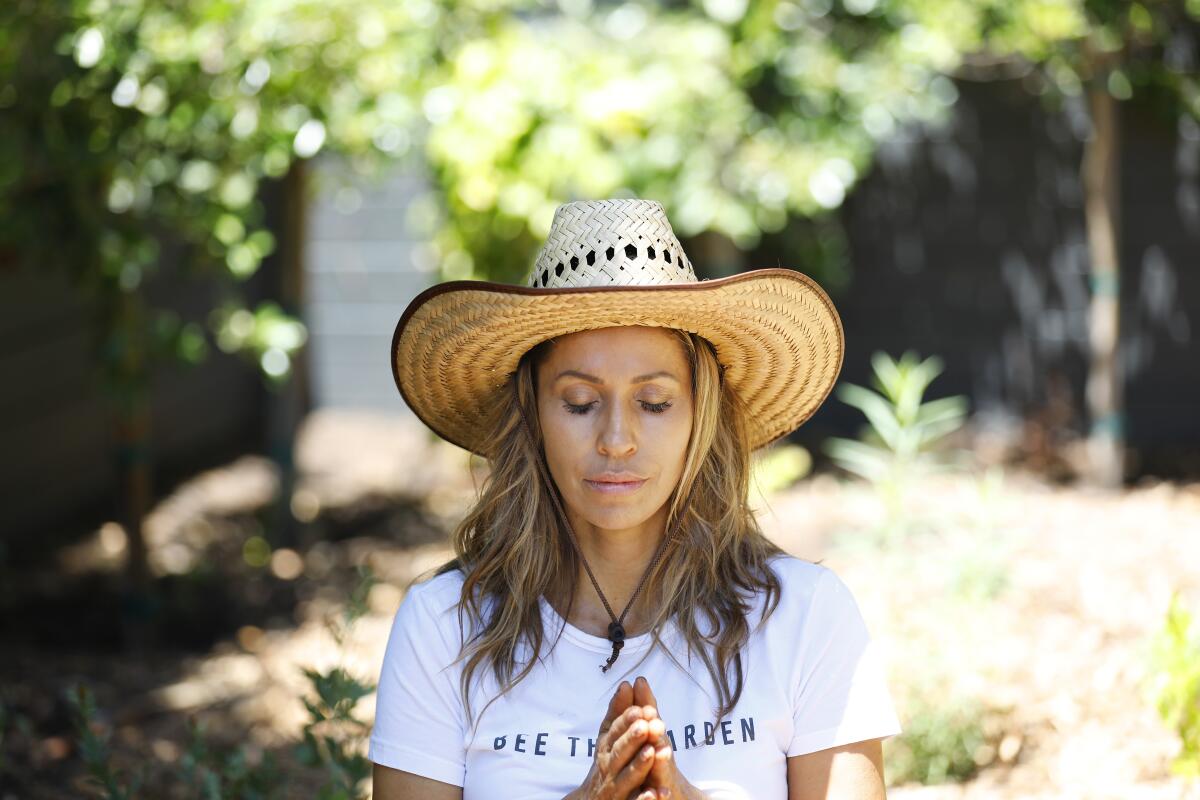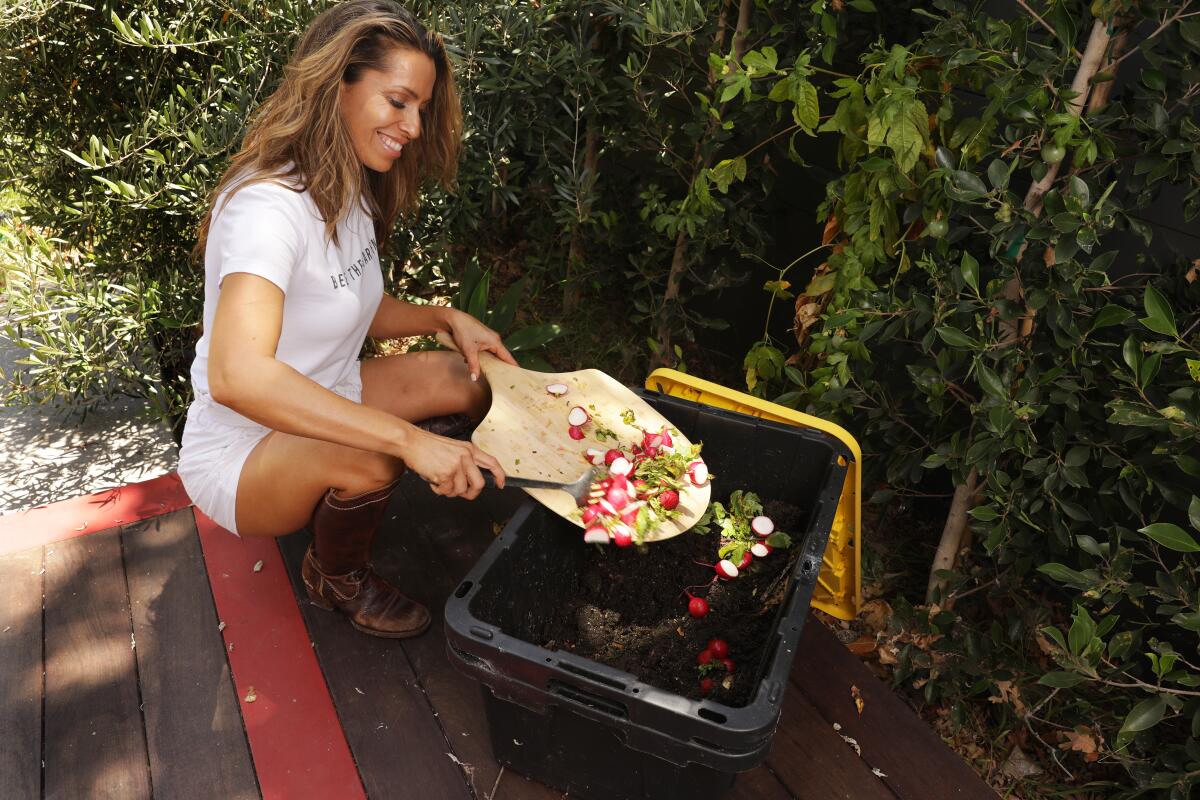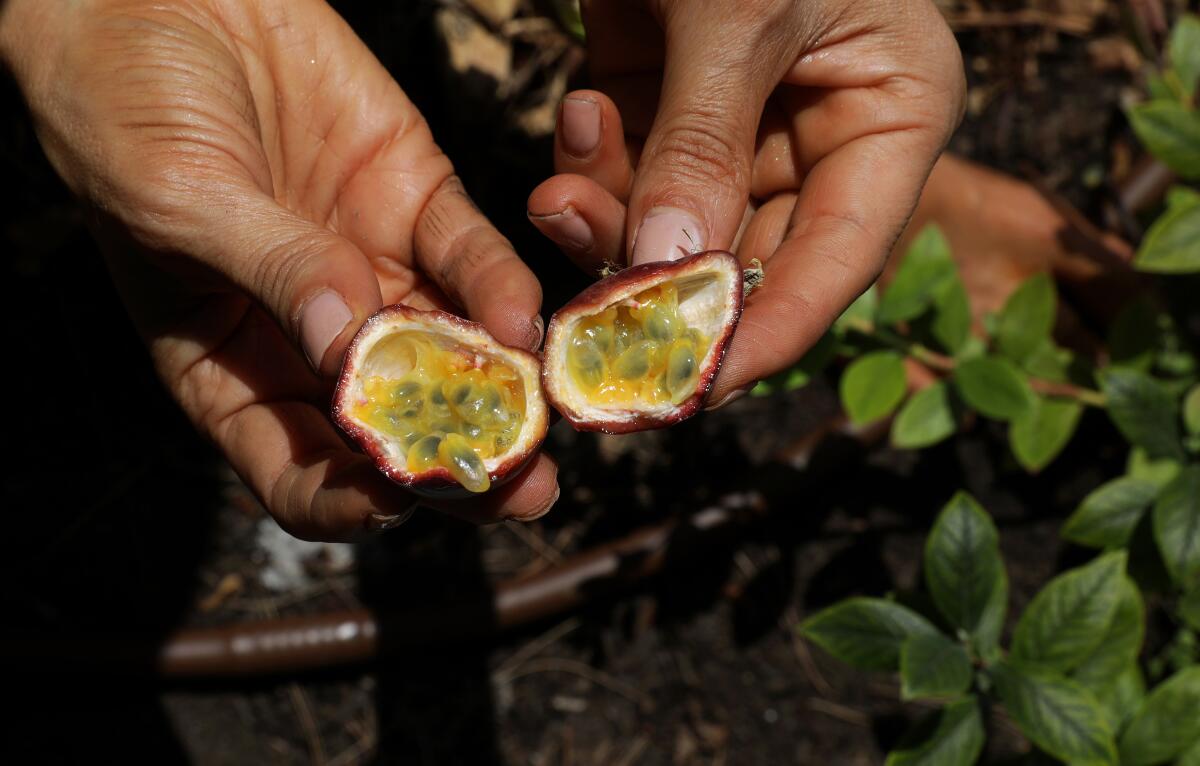Don’t pull the weeds in Rainbeau Mars’ edible garden

Stinging nettles are aptly named, as any unwary hiker or gardener can attest, but for actress turned Instagram wellness guru Rainbeau Mars, discomfort is a small price to pay for the weed’s many benefits. So when Mars removed the lawn outside her Venice home this summer, she sowed a big patch of stinging nettle seeds in her new edible landscape, just as she’s done at her two previous homes in Culver City and Beverly Hills.
Nettles have long had a healthful reputation, and adherents use them in juices or teas to combat arthritis or other ailments. But Mars also has an external use for the mint-like plants with prickly, needle-fine hairs. She likes to gently strike them against her thighs, as a precaution against cellulite, or around her face to erase fine lines. And she is impatient with people who might find that odd.
“It feels like a little sting, but so do Botox shots,” she says. “People spend thousands of dollars at the doctor’s office for Botox, but they won’t use a little nettles on their skin? The sting only lasts five minutes or so, and then it feels great.”
Unorthodox perhaps, but Mars can point to herself for results. At 43, she looks as youthful as her 16-year-old daughter, Jade.
Mars’ mother, herbalist Brigitte Mars, has written more than a dozen books about herbal medicine and beauty, but Rainbeau Mars has created her own niche in the natural world, as an accomplished yoga instructor (with multiple DVDs) and enthusiastic proponent of plant-based diets and essential oils. Her 2014 book, “The 21-Day SuperStar Cleanse,” is dedicated, in part, to Mother Earth, a passion that inspires her urban landscaping as much as her lifestyle. She has 150,000-plus followers on Instagram.

“We need to give back to the earth by feeding the soil,” says Mars, “and if we’re going to use water to grow something, why not grow some food?”
Her ideas are inspired by Australian soil health educator Graeme Sait, owner of Nutri-Tech Solutions, who advocates building humus and healthy soil to improve crop yields.

It’s not enough to just stay away from pesticides or chemical fertilizers, Mars believes. Instead of wasting resources on “useless lawns,” she says, and filling landfills with clippings, we should give back to the earth by adding organic amendments to our soil, like compost, decaying leaves and worm castings — the regurgitated mix of soil and food waste eaten by worms. Mars keeps a homemade worm bin in her backyard, where she regularly mixes dirt with leftover watermelon rinds and vegetable peels to feed red wriggler worms and create her own worm castings.

The Venice house is the third yard Mars has changed from lawn to an edible landscape with the help of Matthew Van Diepen, owner of Home Grown Gardens, who does most of the digging, planting and mulching. “I brought out lemonade to keep them cool,” she laughed, but the design and plant choices were hers.
She’s tackled only the front yard, removing about 900 square feet of lawn, said Van Diepen, and getting a $2-per-square-foot rebate from the city for changing to a drought-friendly landscape.
Mars said she chooses plants that are beautiful as well as useful and her new landscape is thick with young plants, wood-chip mulch and a few dandelions sprouting in the corners. (“Dandelion leaves are delicious, and good for your liver.”) A ficus hedge along the front fence has been replaced by strawberry guava trees and passion fruit vines. Ficus “have super invasive roots that suck nutrients and water from the soil,” Van Diepen said, “so you don’t want that kind of hedge in an edible garden.”
Some of the plants are traditional garden fare, like tomatoes and raspberries and herbs such as thyme, oregano, lavender and rosemary. But they also include handsome sprays of lemongrass and aloe, dotted with sweet potatoes, Matilija poppy, yarrow, native narrow-leaf milkweed, asparagus, nicotiana (known for its evening fragrance) and Mexican marigolds.

Here are Van Diepen’s tips for pulling out a lawn, improving the soil and creating an edible garden:
Get ready to sweat
Van Diepen used a pickax with a wide (5-inch) head to dig up Mars’ old lawn, “a weekend of intensive labor,” he laughed. For larger yards it’s possible to rent turf cutters that cut strips of lawn that can be rolled up and carted away; just keep the rolls small because they get heavy very quickly. Van Diepen doesn’t like techniques that use plastic or herbicides to kill the the grass because those also kill the microorganisms that help create healthy soil. His goal is to retain as much of the native soil as possible.
Add compost, not topsoil
Once you’ve recovered from removing the lawn, go somewhere that sells good bulk compost. Never use topsoil, Van Diepen says, because you’re introducing a non-native soil to your yard. The goal is to add organic matter to enrich the existing soil. Van Diepen got his compost from BD White Top Soil Co. in Gardena. He used one large pickup load, about 3 cubic yards, for the 900-square-foot area, spading in the compost so the yard’s soil was about half compost. Check the source of your compost, van Diepen said. Composted manure can be a problem, for instance, if the animals were fed antibiotics. The same goes for municipal composting facilities, which may include clippings with herbicide or pesticide residue. “Your compost is only as good as the ingredients.”
Plant and install drip irrigation lines
Pay attention to the tags on your plants so you space them appropriately. Don’t add fertilizer or too many amendments in the holes for native plants, because they prefer native soil. You may not save a huge amount of water, especially in the beginning, because the new plants need regular watering to get established, but at least you are growing something you can eat, Mars said. And expect to rotate certain plants depending on the season; for instance, pull out tomatoes in the late fall and plant cool-weather crops, such as lettuces or broccoli.
Mulch thickly
Van Diepen advocates using fallen leaves or larger wood chips for a thick mulch, to discourage (unwanted) weeds and retain moisture. Many tree-trimming companies will happily give you their wood chips, he said, because it saves them the cost of disposal. But be prepared for a big pile, which you should spread at least 3 to 4 inches thick on your new garden.
More to Read
Sign up for our L.A. Times Plants newsletter
At the start of each month, get a roundup of upcoming plant-related activities and events in Southern California, along with links to tips and articles you may have missed.
You may occasionally receive promotional content from the Los Angeles Times.







